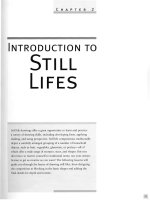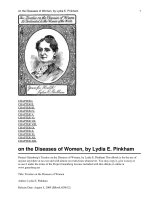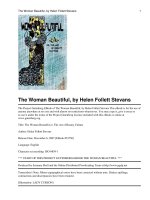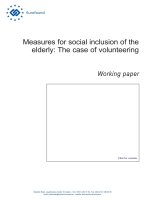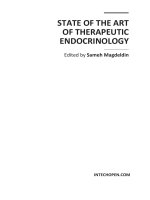THE ART OF MIDWIFERY doc
Bạn đang xem bản rút gọn của tài liệu. Xem và tải ngay bản đầy đủ của tài liệu tại đây (1.2 MB, 256 trang )
THE ART OF MIDWIFERY
THE WELLCOME INSTITUTE SERIES IN THE
HISTORY OF MEDICINE
Edited by W.F.Bynum and Roy Porter The Wellcome Institute
Florence Nightingale and the Nursing Legacy
Monica Baly
Vivisection in Historical Perspective
Nicolaas A.Rupke
Abortion in England, 1919–1967
Barbara Brookes
The Hospital in History
Lindsay Granshaw and Roy Porter
Women as Mothers in Pre-industrial England
Valerie Fildes
The Charitable Imperative
Colin Jones
Medicine at the Courts of Europe, 1500–1837
Vivian Nutton
Mad Tales from the Raj
Waltraud Ernst
British Medicine in an Age of Reform
Roger French and Andrew Wear
Doctor of Society
Roy Porter
Medical Journals and Medical Knowledge
W.F.Bynum, Stephen Lock and Roy Porter
Medical Theory, Surgical Practice
Christopher Laurence
The Popularization of Medicine 1650–1850
Roy Porter
Women and Children First
Valerie Fildes, Lara Marks and Hilary Marland
Psychiatry for the Rich
Charlotte MacKenzie
Literature and Medicine during the Eighteenth Century
Marie Mulvey Roberts and Roy Porter
Medicine and the Reformation
Ole Peter Grell and Andrew Cunningham
Sophia Jex-Blake
Shirley Roberts
iii
THE ART OF MIDWIFERY
EARLY MODERN MIDWIVES IN
EUROPE
Edited by
Hilary Marland
London and New York
First published 1993
by Routledge
11 New Fetter Lane, London EC4P 4EE
This edition published in the Taylor & Francis e-Library, 2005.
“To purchase your own copy of this or any of Taylor & Francis or Routledge’s collection
of thousands of eBooks please go to www.eBookstore.tandf.co.uk.”
Simultaneously published in the USA and Canada
by Routledge
29 West 35th Street, New York, NY10001
First published in paperback by Routledge in 1994
© 1993 Selection and editorial matter, Hilary Marland; individual chapters, the
contributors.
All rights reserved. No part of this book may be reprinted or
reproduced or utilized in any form or by any electronic,
mechanical, or other means, now known or hereafter
invented, including photocopying and recording, or in any
information storage or retrieval system, without permission in
writing from the publishers.
British Library Cataloguing in Publication Data
A catalogue record for this book is available from the British Library
Library of Congress Cataloging in Publication Data
The Art of Midwifery: Early Modern Midwives in Europe/edited by
Hilary Marland.
p. cm.— (The Wellcome Institute series in the history of medicine)
Includes bibliographical references and index.
1. Midwives— Europe— History. I.Marland, Hilary. II. Series.
[DNLM: 1. Midwifery—history— Europe. WQ 11 GA1 A7]
RG950.A69 1993
618.2′0233′094–dc20
DNLM/DLC
for Library of Congress 92–49026
CIP
ISBN 0-203-99152-4 Master e-book ISBN
ISBN 0-415-06425-2 (hbk)
ISBN 0-415-11675-9 (pbk)
Contents
List of illustrations viii
Notes on contributors ix
Acknowledgements xii
Abbreviations xiii
Introduction 1
1. Mothers and their midwives in seventeenth-century London
Doreen Evenden
9
2. Provincial midwives in England: Lancashire and Cheshire, 1660–
1760
David Harley
27
3. Midwifery practice among the Quakers in southern rural England
in the late seventeenth century
Ann Giardina Hess
49
4. The midwives of south Germany and the public/private
dichotomy
Merry E.Wiesner
77
5. From hegemony to subordination: midwives in early modern
Spain
Teresa Ortiz
95
6. The politick midwife: models of midwifery in the work of
Elizabeth Cellier
Helen King
115
7. Midwife to a nation: Mme du Coudray serves France
Nina Gelbart
131
8. The Church, the State and childbirth: the midwife in Italy during
the eighteenth century
Nadia Maria Filippini
153
9. Professionals? Sisters? Rivals? Midwives in Braunschweig,
1750–1800
Mary Lindemann
177
10. The ‘burgerlijke’ midwife: the stadsvroedvrouw of eighteenth-
century Holland
Hilary Marland
193
Select bibliography 215
Index 225
vii
Illustrations
Tables
1.1 Frequency of contact between London midwives and clients, 1662
(based on testimonials)
11
1.2 Frequency of contact between Mistress X and her clients, 1694–1723
(account book)
12
1.3 Occupation/status of the husbands of London midwifery clients,
1663–1700
18
9.1 Relative sizes of midwifery practices in Braunschweig, 1797 190
Figure
3.1 Location of Quaker childbirths attended by thirty midwives active in
the Upperside and Lowerside monthly meetings of Buckinghamshire,
1652–1718
54
Contributors
Doreen Evenden is assistant professor of history at Mount Saint Vincent
University, Halifax, Nova Scotia. She is author of Popular Medicine in
Seventeenth-Century England (Bowling Green State University Popular Press,
1988). Her PhD dissertation ‘Seventeenth-century London midwives: their
training, licensing and social profile’ (McMaster University, 1991) was
awarded the Canadian Historical Association prize for the best doctoral thesis
(1991) on a non-Canadian topic, and is being prepared for publication with
Cambridge University Press. Professor Evenden’s current research interests
include early modern England, especially London, and female medical
practitioners and midwives.
Nadia Maria Filippini lives and teaches in Venice. Her research concerns the
history of women, in particular women’s work and the history of childbearing.
A founder member of the Italian Society of Women Historians (S.I.S.), her
publications include Noi, quelle dei campi. Identità e rappresentazione di sé
delle contadine veronesi del primo novecento (Gruppo Editoriale Forma,
1983) and, together with other scholars, Nascere a Venezia. Dalla Serenissima
alla Prima Guerra Mondiale (Gruppo Editoriale Forma, 1985) and Le Culture
del parto (Feltrinelli, 1985). She is editor of Perle e impiraperle. Un lavoro di
donne a Venezia tra ’800 e ’900 (Arsenale, 1989). She has also published
extensively in major history journals, Quaderni Storici, Società e Storia,
Memoria. Rivista di Storia delle Donne, Storia e Dossier and Sanità, Scienza e
Storia, and is concluding her thesis for the Doctorat en Histoire (3ème cycle)
at the École des Hautes Études en Sciences Sociales in Paris, where she was
Maître des Conferences during the year 1988–89.
Nina Gelbart is professor of History at Occidental College in Los Angeles,
California. She is the author of Feminine and Opposition Journalism in Old
Regime France: Le Journal des Dames (University of California Press, 1987),
which won the Sierra Prize, the ‘Introduction’ to a new translation
of Fontenelle’s Conversations on the Plurality of Worlds (University of
California Press, 1990), and of articles on Enlightenment utopias, medical
journals and radical editors. Professor Gelbart is preparing a biography of the
midwife Mme du Coudray, entitled Delivering the Goods: the Midwife
Mission of Mme du Coudray in 18th Century France. Her current research
focuses on the medical press and on Charlotte Corday, the ‘saint/assassin’ of
Marat.
David Harley teaches History in Oxford. He has published several articles on
early modern medicine, including a study of the midwife-witch.
Ann Giardina Hess is currently a student at Harvard Medical School. She
received a BA in American Studies from Yale College in 1987. She is working
towards a PhD in History from Cambridge University, England, for a thesis on
local midwifery practice in village and town communities in England and New
England, c. 1650–1750. During her tenure as a full-time PhD student and
Marshall Scholar she was on leave between 1988 and 1991 to work at the
Wellcome Unit for the History of Medicine in Oxford.
Helen King took her first degree in Ancient History and Social Anthropology
in 1980, and completed a PhD thesis on Hippocratic gynaecology in 1985,
both at University College London. Between 1983 and 1986 Dr King held a
Henry Sidgwick Research Fellowship at Newnham College Cambridge and in
1986–87 a Sir James Knott Research Fellowship at the University of
Newcastle. Since 1988 she has been a lecturer in History at Liverpool Institute
of Higher Education. Dr King has published many articles on women in
ancient myth and medicine and on the history of gynaecology, and is the
author of a section on the history of hysteria from the Greeks to the
seventeenth century in S.Gilman, H.King, R.Porter, G. Rousseau and
E.Showalter, Hysteria Before Freud (University of California Press,
forthcoming).
Mary Lindemann is associate professor of History at Carnegie Mellon
University and author of Patriots and Paupers: Hamburg 1712–1830 (Oxford
University Press, 1990). She is currently working on a history of health and
healing in northern Germany in the seventeenth and eighteenth centuries as
well as preparing a volume on Medicine and Society in Early Modern Europe
for the series ‘New Approaches to European History’ (Cambridge University
Press, forthcoming).
Hilary Marland is author of Medicine and Society in Wakefield and
Huddersfield 1780–1870 (Cambridge University Press, 1987), and together
with M.J.van Lieburg and G.J.Kloosterman of ‘Mother and Child Were
Saved’. The Memoirs (1693–1740) of the Frisian Midwife Catharina Schrader
(Rodopi, 1987). She jointly edited with Valerie Fildes and Lara Marks Women
and Children First. International Maternal and Infant Welfare 1870–1945, for
the Routledge Wellcome Series in the History of Medicine (1992). She has
also published on the history of dispensaries, the nineteenth-century Yorkshire
medical profession, chemists and druggists, early Dutch women doctors and
Dutch midwifery. Employed as research officer at the Instituut Medische
Geschiedenis, Erasmus Universiteit Rotterdam, Dr Marland’s interests include
the history of preventive medicine in the Netherlands, women medical
x
practitioners, and the history of Dutch midwives 1700–1945. She is holder of a
Wellcome Research Fellowship for a project on the Dutch midwifery
professions in the twentieth century.
Teresa Ortiz, a graduate in medicine, received a PhD in the history of
medicine from the University of Granada in 1987 with a dissertation on the
medical profession in twentieth-century Andalucía, Médicos en la Andalucía
del siglo veinte: distribution, especialismo y participación profesional de la
mujer (Fundación Averroes, 1987). Professor Ortiz teaches courses on the
history of medicine and women in the health professions at the University of
Granada, where she is director of the Women’s Studies Institute. She is
currently working on ‘Health professions in the eighteenth century’ and
‘Gender and Spanish medical discourse’.
Merry E.Wiesner is an associate professor of History and director of the
Centre for Women’s Studies at the University of Wisconsin-Milwaukee. She
is author of Working Women in Renaissance Germany (Rutgers University
Press, 1986), Women and Gender in Early Modern Europe, 1500–1750
(Cambridge University Press, forthcoming), and a number of articles on
women and the Reformation, the relationship between work and gender, and
other aspects of early modern German social history.
xi
Acknowledgements
Although an edited volume—so much a joint effort between editor and authors—
is perhaps not the most appropriate place to list acknowledgements, it is a pity to
waste the opportunity. Thanks go to Bill Bynum and Roy Porter, editors of the
Wellcome series, for their encouragement of the project. Gill Davies of Routledge
was especially helpful in the early stages of the book, Brad Scott in the latter. I
would particularly like to acknowledge the contribution of Maggie Pelling, who
has been, from the first idea for the book to its final execution, a source of help,
good advice and friendship. I would also like to thank the other colleagues and
friends who have helped and kept me going in many different ways while this
volume was being prepared: Lara Marks, Rita Schepers, Mart van Lieburg, Frank
Huisman, Netty Storm, Erma Hermans and Iona Dekking (and their families),
Tini Wiersma, the girls at the Woezelhuis and my parents. The authors have all
been fantastic, co-operative, supportive and encouraging, especially in the latter
stages, as I raced to complete the manuscript before the birth of my second child.
But the most important people to thank of course are my husband Sebastian,
victim at all times of my balancing acts, and my children Daniel and David.
Abbreviations
Chapter 1
CuRO Cumbria Record Office
GL Guildhall Library
GLRO Greater London Record Office
LPL Lambeth Palace Library
Chapter 2
BL British Library
CCRO Chester City Record Office
CRO Cheshire Record Office
DM Diocesan Miscellany
LCRS Lancashire and Cheshire Record Society
LRO Lancashire Record Office
PRO Public Record Office
WRO Wigan Record Office
Chapter 3
BRO Buckinghamshire Record Office
CuRO Cumbria Record Office
DRO Dorset Record Office
FHL Friends’ House Library
HRO Hertfordshire Record Office
PRO Public Record Office
Chapter 4
AStB Nuremberg Staatsarchiv, Amts- und Standbücher
BMB Frankfurt Stadtarchiv, Burgermeisterbücher
RB Nuremberg Staatsarchiv, Ratsbücher
RPB Memmingen Stadtarchiv, Ratsprotokollbücher
RSP Munich Stadtarchiv, Ratsitzungsprotokolle
Chapter 5
AGS Archivo General de Simancas
AMM Archivo Municipal de Málaga
LAC Libro de Actas Capitulares
Chapter 6
BL British Library
Chapter 7
AD Archives Départmentales
AN Archives Nationales
MC Minutier Central
Chapter 8
ASV State Archives of Venezia
ASVR State Archives of Verona
Chapter 9
MO 1757 Serenissimi gnädigste Verordnung, das Hemammenwesen
betreffend. De Dato Braunschweig, von 18. Febr, 1757
StadtB Stadtarchiv Braunschweig
StAWf Niedersächsisches Staatsarchiv-Wolfenbuttel
xiv
Chapter 10
GAD Gemeente Archief Delft
GAR Gemeente Archief Rotterdam
ONGD Archief van het Oude en Nieuwe Gasthuis te Delft
xv
xvi
Introduction
The absorption of midwifery into medical practice is a recent process, a
development linked in many western countries with the diminishing role of
midwives, the increased involvement of the man-midwife, the general
practitioner and the obstetrician in the birthing process and, in the twentieth
century, the increased hospitalization of childbirth. While it is generally
recognized that the midwife has been with us since biblical times, and that
midwifery is the oldest female occupation and without doubt one of the most
important, the focus of historical studies has been very much on this process of
decline in the midwife’s place in obstetric work—on competition between the
traditional midwife and her male rivals, the increase in medical intervention and,
as the role of women in the birth process diminished, the shift in emphasis in
childbirth from the social to the medical sphere.
This volume is concerned with midwives in the period 1400 to 1800,
midwives as birth attendants, as women workers, as active members of their
communities, as ‘missionary’ and political figures, and as defenders of their
status and occupation against the invasions of male practice. It explores the
period before the ‘decline’ and, if it challenges some of the long-held beliefs
about midwives, their lives, work, social standing and place in public life, it will
have achieved one of its major objectives.
The essays—covering England, Germany, Holland, France, Italy and Spain—
draw on an impressive range of manuscript and printed material—church
licensing records, testimonials, parish registers, baptismal rolls and records of
birth registration, wills, censuses, court records, municipal ordinances,
regulations and licences, midwives rolls, the archives of guilds and medical
corporations, religious, political and medico-political pamphlets and obstetric
literature. And, if the volume shows the vast number of possibilities in terms of
source material for building up a picture of early modern midwife practice, it
will have achieved a further objective.
The early modern period was neither a ‘golden age’ for midwives, nor was it a
time when midwifery was practised by aged unskilled crones on a hapless and
helpless female population. The poverty of the ‘ignorant midwife’ theory has
been further demonstrated in this volume, as has the notion that most midwives
practised with only the most rudimentary knowledge and training. Yet the early
modern period was, as the essays show, a period of great diversity, of variation
between and within Western European countries, in terms of midwives’
practices, skills and competence, their socio-economic background and
education, their training and qualification to work, and their public functions and
image.
The work of midwives varied greatly—what midwives were allowed by law
or custom to do, and what they actually did do. Urban/rural divides were often
superimposed on to national contrasts in midwives’ practices. Some midwives
attended births on an occasional basis, as a form of neighbourly support and
female bonding, while others worked steadily at their chosen occupation for the
greater part of their lives, earning a regular income. For some women attendance
at a childbirth was no more than being a good friend or relation, for others it was
perhaps the family’s chief source of income.
The first three chapters illustrate this diversity of occupational status and
practice in seventeenth- and eighteenth-century England. Doreen Evenden’s
essay on London midwives, drawing largely on ecclesiastical licensing records,
focuses on the relationship between midwives and their clients, giving an insight
into how childbearing women perceived those who delivered them (Chapter 1).
The importance of ‘repeat practice’, sometimes stretching across generations,
and the relevance of female (and male) networking and recommendations, is
demonstrated, as London midwives built up a loyal clientele, often over a wide
geographical area. London midwives throughout the seventeenth century
attracted clients from a broad social spectrum, and well-to-do women
demonstrated active support for their midwives by providing testimonials for
licence applications.
In his discussion of midwifery practice in the northern English counties of
Lancashire and Cheshire between 1660 and 1760, David Harley reveals great
contrasts in the recognition accorded to midwives, and in their licensing and
working practices and incomes (Chapter 2). Many midwives, practising on an
occasional basis, found it too costly and troublesome to obtain licences; others,
working more regularly at their occupation, gained esteem and co-operated
closely with local medical practitioners.
The working practices of Quaker midwives in southern rural England in the
late seventeenth century are explored by Ann Giardina Hess (Chapter 3). The
activities and clientele of Quaker midwives are revealed through the unique
system of Quaker birth registration, which listed birth witnesses, giving the
opportunity to investigate the nature of neighbourly, kin and religious ties
between parents and midwives. Ann Hess emphasizes the great diversity of
practice, from women who attended at just a few births during the course of their
lifetime, to those who worked seriously at their occupation, building up a widely
distributed clientele and considerable fame across several counties. While clients
often used a succession of different midwives, Ann Hess confirms the
importance of networking in their selection, and demonstrates how preferences
for childbirth attendants could override considerations of religious belief. There
2INTRODUCTION
was a high level of integration of Quaker and parish women, even amongst the
highest social strata, in the delivery room, as both midwives and helpers. Though
Quaker midwifery practice was clearly a special case, it also provides a case
study of early modern midwife practice, revealing the social exchanges between
midwives and their clients.
While some midwives attended only a small number of births, in a number of
countries in continental Europe a very different type of midwife was being
employed during the early modern period, as a municipal employee undertaking
obstetric work on a day-to-day basis, as a long-term career option, which could
involve considerable investment in the costs of qualifying and obtaining a
licence. The employment practices of town authorities—and the deals for the
midwives as municipal employees—in Germany and the Netherlands are
explored by Merry Wiesner, Mary Lindemann and Hilary Marland (Chapters 4,
9 and 10). Their conditions of work varied. Merry Wiesner, examining six towns
in southern Germany between 1400 and 1800, outlines how midwives’ salaries
were kept to a minimum, while a stepping up of supervision by the so-called
‘honourable women’ and the town physicians undermined their status and
independence (Chapter 4). In eighteenth-century Braunschweig, midwives were
subjected to similar poor conditions of service (Chapter 9), but in the towns of
Holland during the seventeenth and eighteenth centuries the picture was one of
increased regulation and increased costs of qualifying to practise, but also of
rising financial incentives, as the town authorities struggled to respond to a
shortage of licensed midwives (Chapter 10). In France, one outstanding midwife,
Mme du Coudray, whose life story is outlined by Nina Gelbart, was appointed on
a very different basis, as King Louis XV’s missionary and teacher, to spread
obstetric knowledge and re-educate midwives throughout the French provinces,
work she endured for some three decades (Chapter 7).
In all countries, there was enormous variety in the paths taken to setting up in
practice as a midwife. David Harley, arguing that midwifery was a skill to be
learned by experience and passed on without formal instruction, reveals the often
informal and irregular routes to practice in northern England (Chapter 2). Yet in
seventeenth-century London apprenticeship, often lengthy, remained important
(Chapter 1), while amongst Quaker midwives the system of assisting senior
midwives grounded younger women in good midwifery practice (Chapter 3). At
a time when the importance of the midwife and her role as childbirth attendant
was supposedly diminishing, groups of women were emerging across Europe
who had undergone a sometimes extensive formal training. The town authorities
and medical hierarchies of continental Europe recognized the need for trained
and licensed midwives, fit and competent to practise, who were necessary for the
maintenance of a healthy population. In Italy and Spain schools for midwives were
established in the eighteenth century, in Holland courses set up during the
seventeenth century, given by the towns’ medical corporations, were extended in
the eighteenth. Yet apprenticeship remained everywhere the norm and key to
practice, even in countries where initiatives were being made to educate a new
INTRODUCTION 3
breed of school- or theoretically-trained midwives, and where book-learning was
encouraged. Though many ‘apprenticed’ midwives received no recognition from
the authorities, except perhaps that they constituted a danger to the health and
welfare of women and the babies they delivered, they frequently enjoyed great
popularity, and their skills were still in the eighteenth century often grounded in
long apprenticeship with a senior midwife and years of experience.
It is the ‘average’ midwife, the woman who worked quietly in her community,
be it village, town or metropolis, who comes to the fore in this volume. Given the
enormous variety in the standing and practices of these women, can we come any
closer to defining the early modern midwife? In all the countries covered,
midwives shared certain characteristics—most were mature women, married or
widowed, who started to practise when they had grown-up families, most were
trained by some form of apprenticeship, formal or informal, most were of
middling status, the wives of artisans, craftsmen, tradesmen or farmers, for whom
the practice of midwifery, though not necessarily vital for the family income,
was a useful addition. Several of the essays in this volume suggest that up until
the eighteenth century women of considerable social and economic standing
practised midwifery, although there was great variation in both directions. David
Harley outlines the wide range of social backgrounds of midwives working in
Lancashire and Cheshire in the second half of the seventeenth century and first
half of the eighteenth—from the prosperous to the very poor who were paid for
their midwifery work in lieu of poor relief. Yet many midwives, he argues,
especially in the heyday of the seventeenth century, were of considerable social
standing, respectable and literate (Chapter 2). These attributes of respectability
and literacy were shared by many midwives across Europe during the early
modern period.
The essays in this volume emphasize the need for wariness in approaching
midwife history from the standpoint of a contest, in which the midwife was
ultimately the loser, between female and male obstetric practitioners. The story is
a much more complicated one than that of a simple decline from the seventeenth
or eighteenth century onwards, of men-midwives moving into childbirth,
regarded increasingly as a socially acceptable and potentially lucrative field,
armed with their new instruments and social charms, and eventually extending
their competence to include normal deliveries. By the mid-eighteenth century,
however, changes were afoot in England. While Doreen Evenden demonstrates
high levels of loyalty to midwives in London during the seventeenth century,
even amongst the affluent (Chapter 1), half a century later in the rural areas of
the south and north of England men-midwives were carrying out more
deliveries. Men-midwives officiated at Quaker births in the rural south from the
1750s onwards (Chapter 3). David Harley suggests that for a combination of
reasons—exploitation by the men-midwives, boasting greater skills and
education, the lack of good midwives, and changes in tastes as the social gap
between clients and midwives widened—a similar process was under way in the
4INTRODUCTION
provincial north, where male practitioners were also replacing midwives as
expert witnesses (Chapter 2).
Yet, we should certainly not take the English model as typifying what was
going on in the rest of Europe. As Mary Lindemann demonstrates for the case of
Braunschweig, little effort was being made to nose midwives out of obstetrics in
eighteenth-century German towns (Chapter 9). In Holland, Hilary Marland argues,
the stepping up of midwife regulation was geared more towards control and
supervision than eliminating midwives or reducing their work-loads; on the
contrary, their role as attendants in normal cases of childbirth was assured by the
end of the eighteenth century (Chapter 10). Midwives themselves were
concerned with issues other than the challenge of male obstetric practice—and
they were not afraid to complain about their salaries and status, their duties in the
community, questions of citizenship, the poor quality of training, problems
between midwives and their apprentices, or annoyance about the incursions of
‘quack’ midwives (Chapters 4, 9 and 10). Midwives’ work was just as much
shaped by these issues as by the directives of the town authorities and medical
hierarchies.
In Italy, as sketched by Nadia Filippini, a struggle was taking place late in the
eighteenth century between the midwife and her male rivals. Yet complicated by
the tussle between State and Church authorities, the latter supporting and even
arguing for an extension of the midwife’s obstetric and moral authority—
particularly her role in performing baptisms—and by competition between the
school-trained modern midwife and her traditional counterpart, who enjoyed
much popular support, the conclusion of the struggle was far from clear by the turn
of the nineteenth century (Chapter 8). Similarly, in Spain, as Teresa Ortiz
demonstrates, the rise of a group of male practitioners who turned their attention
increasingly to obstetric work and the writing of midwifery manuals—backed by
Enlightenment ideals, and establishing legal and educational control over
midwives by the last quarter of the eighteenth century—did not herald the
immediate decline of the midwife (Chapter 5). In France, the sending out of
Mme du Coudray in 1759 on her mission to re-educate the midwives of France
was hardly symptomatic of a decline in the midwife’s role as normal childbirth
attendant; it was Mme du Coudray’s niece, representing the next generation of
midwives working towards the end of the eighteenth century, who was obliged to
defend herself and her colleague midwives against the male obstetric practitioner
(Chapter 7). In several countries, the impact of new instruments and
interventions, especially the obstetric forceps, as Nadia Filippini shows for Italy,
was less than we have been led to believe, while midwives themselves were not
unfamiliar with the use of instruments (Chapter 8).
Many countries had their own midwife phenomena—Mme du Coudray,
unsurpassed for her diligence and energy in re-educating the rural midwives of
France (Chapter 7), Catharina Schrader with her great stamina and expertise in
difficult childbirth (Chapter 10), the Quaker midwife Frances Kent, renowned
amongst her co-religionists and Establishment aristocrats (Chapter 3), Spain’s
INTRODUCTION 5
Luisa Rosado, taking on the medical authorities head on, defending her right to
practise, to apply her knowledge of difficult childbirth and to administer
medicines (Chapter 5), Holland’s Van Putten sisters, ‘female men-midwives’
who crossed the boundaries between old and new, female and male spheres of
practice (Chapter 10), and Italy’s Teresa Ployant, author of a midwife manual,
and keen to better the standards of midwife practice and to defend women’s
modesty from the ‘horrible’ interventions of men (Chapter 8).
London’s ‘Popish midwife’, Elizabeth Cellier, is one of Europe’s most famed
(and infamous) early modern midwives, and Helen King shows how, embroiled
in religious, political and medico-political affairs and efforts to set up a college
of midwives, she straddled the boundaries between midwifery and politics in
Restoration England. Her work and the pamphlets written by Cellier and the
rivals who denounced her are used as sources to illustrate enduring positive and
negative images of the midwife in seventeenth-century England. The shifting
fortunes of Cellier and her highly public image as plotter and midwife gave
contemporaries the chance to revive chiefly negative images of the midwife as
drunken and lecherous bawd, even consort of the Devil, and has distorted images
of the competence of seventeenth-century midwives. But as Helen King argues,
we should be wary of reading too much into Cellier’s pronouncements; thinking
on her feet, shifting course, first advocating a male-supported college of
midwives, and later criticizing male obstetric practice, may have been simple
survival tactics when it was not a good time to be a Catholic midwife in London
(Chapter 6).
How were midwives, famous ones apart, regarded by those they served and by
the communities in which they worked? Most, even those with regular practices,
had their recognition grounded on other qualities and skills than their work in
delivering babies—as expert witness, public functionary, community member. In
the period of the midwife’s ascendancy, when childbirth, treated as a
physiological process, was dominated by social norms and traditions, and was
firmly rooted in female culture, the midwife straddled two spheres, helping
women in the birthing process and supervising events in the delivery chamber. Ann
Hess demonstrates that for Quaker midwives, their public recognition was just as
likely to rest on their role as members of women’s meetings, senior women in
the community, and arbitrators in cases of domestic dispute and cases of sexual
misdemeanour, rape, incest, infanticide or physical abuse (Chapter 3). Moral
integrity and religious conformity, David Harley argues, were vital in ensuring
midwives’ suitability to testify in court, to question the mothers of bastard
children in extremis, to decide on cases of ante-nuptial fornication or infanticide
(Chapter 2). In Italy too, the midwife’s duties went far beyond that of childbirth
attendant; the Church was especially keen to preserve this role and establish
authority over her administration of emergency baptisms, which brought the
Church into direct conflict with the State authorities in the eighteenth century
(Chapter 8).
6INTRODUCTION
Similar duties were expected of municipal midwives in south Germany, as
explored by Merry Wiesner, who questions if and how midwives were able to
bridge the gap between public and private during the early modern period.
Midwives’ involvement in administering emergency baptisms and reporting on
illegitimate births, abortion and infanticide increased between 1400 and 1800 and
yet, at the same time, became a cause of increasing anxiety on the part of town
authorities concerned to reduce women’s involvement in roles deemed ‘public’.
The duties of midwives examined in the six south German towns provide a
counter-example to the notion that the trend was to reduce women’s public
activities and restrict them to the private domestic sphere in the early modern
period. Yet it was a case of necessity. The municipal authorities, Merry Wiesner
argues, were prepared to overlook the continuing public role of midwives
because of midwives’ perceived respectability as lower middle-class citizens and
because the work they did was crucial. At the same time, the town councils were
minimizing the importance of midwives’ role in childbirth; their salaries were
kept low, and they were placed increasingly under the control of the municipal
and medical authorities (Chapter 4).
Midwives—and not just the more visible and famed ones—were subject to
shifting social, economic, political and religious forces, be it the changing
fortunes of Catholics in Cellier’s Restoration London, the treatment meted out to
Quakers, persecuted for non-payment of tithes and refusal to attend to the norms
of baptism and churching, the decline in ecclesiastic licensing in England, the
major shifts in du Coudray’s fortunes as first war and then Revolution swept
France, the economic decline of Dutch towns in the eighteenth century, and the
tussles between State and Church in Italy and Spain, with the midwife caught
between the forces of tradition and change, religious morality and Enlightened
government. The areas of struggle which have previously been emphasized
between male and female practice, interventionist versus natural childbirth and
changes in social demand, were overlaid by wider forces, which could affect the
work and status of midwives, even those working quietly in their village or town
communities, apparently immune to such great issues and sweeping forces.
Early modern midwives were not administering angels—they were ordinary
working women, wage-earners, with a sense of pride in their occupation, though,
given the conditions under which childbirth often took place in this period, many
midwives must have had special qualities, of patience, forbearance, physical and
mental strength, and fellow-feeling. The ‘art of midwifery’ as practised by
midwives across Europe through the early modern period was rich and diverse;
the midwife remained throughout the period, the normal attendant in childbirth,
and yet her role was much wider. Nor was the midwife a passive victim of
events; she adapted, fought back and, though it was clear that the turn of the
nineteenth century was going to mark a change, and often decline, in the practice
of her art, this change was more subtle, slower to take effect and more complex
than we have realized.
INTRODUCTION 7
8
